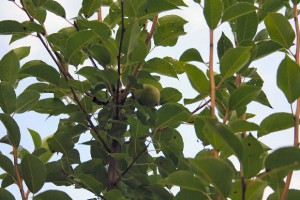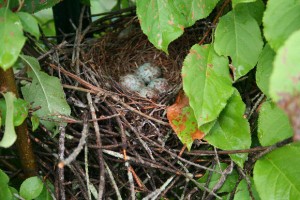We have 17 acres total here at Seven Oaks, but only 3 are cleared, and of the three acres that are cleared, about 1/2 an acre is dedicated to the fruit orchard. We ordered and planted 26 trees from the Arbor Day Society, carefully noting which varieties needed pollinators and how far to space them and what not. We have 10 apple trees, 4 pears, 4 peaches, 4 plums, 2 cherries and 2 apricots. One peach tree that looked as if it was dying was moved to an ornamental flower bed behind the house; we expected it to die, but were astonished when it regained its vigor. Now it’s the largest peach tree on the entire property.
 |
| One lonely pear, but it’s a start! |
 |
| Peaches starting to ripen |
When we planted the trees, we knew we were in for a long wait before we’d harvest the first fruits. All of the gardening books said that standard size trees (which the apples are, for example) and semi dwarf and dwarf (all the rest) take 5 to 7 years before reaching a size capable of bearing fruit. So we wait, and tend them lovingly. Each year we spray them with organic oil sprays and weed around the bases. We trim off the suckers growing near the base and we trim up the branches. John hauls the hose out to each one during the annual summer drought, watering them carefully. It was while watering the apple trees this weekend that he noticed a lovely surprise visitor; a bird’s nest in the lower branches of the apple tree. A quick search online and putting two and two together identified the eggs as mockingbird eggs.
In the mornings when I sit on the front porch with Shadow, I often see the mockingbirds fly from the flower garden on my right across the empty field to the orchard on the left. We’ve heard crows and mockingbirds battling near the orchard, but I assumed the mockingbirds had nested among the pines. They’ve chosen the apple tree to raise their young, and this morning, the mother bird was guarding the nest. John was careful not to disturb her; the poor apple tree will have to wait and let nature water it.
Another lovely surprise was finding fruit on the trees! Given all that we’d read, we were ready to wait another year or two before looking for fruit, but we have one pear maturing on a tree; about 6 odd looking peaches on another; and 2 peaches on the tree in the back of the house. The peaches seem to be exuding some kind of sap, and one is rotted at the bottom, but the others are turning peachy-shades; I have no idea if we’ll get to enjoy them or if the squirrels and deer will beat us to them. My sister has an apple tree growing in a pot on her back deck and waited patiently for the lone apple to mature, but just as it turned ripe, she found it abandoned on the deck with telltale teethmarks and one chomp taken out of it. The squirrels had found it.
One of the joys of living in the country now is finding wildlife like the bird’s nest. Oh sure, you can see birds’ nests in suburbia; my friend Janet, whose apartment is near Central Park, even had hawks nesting on a door lintel near her apartment building, and she used binoculars to watch them. You can find birds everywhere! My brother on Long Island had cardinals nesting in his front bushes, and when my brother and sister were little, they watched a robin raise her young on a maple tree branch right outside their bedroom window. But I love attracting birds to the garden, and it is finding little surprises, like the nest in the orchard and the few first fruits of the season, that make country living so much fun.





